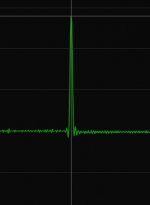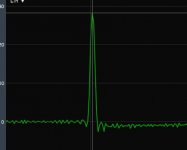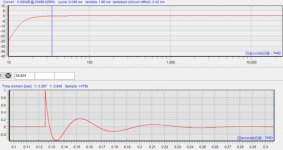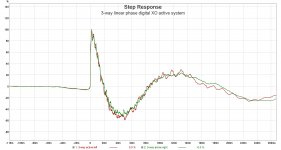You are actually right regarding the usability of the pulse response since even an adventurous phase response can look quite good as pulse response (that's why I prefer the step-response).
OTOH your examples have pre- and post-ringing like I have never ever seen with a real life example.
Regards
Charles
All the ripples are from using a couple of daisy chained sound cards running at different sample rates.
Already had the setup in place working on another project, and was able to make the quick and nasty impulse set.
A gentle low pass at the upper top of the freq range cleans em up.
It's more evidence on why I think impulses are good for confirmation only...they are too fickle to inconsequential items, like adding a mild 20kHz lpf just now to get rid of digital gobblygook.
Step is better, but still hard to read, and in the end.....
what knobs apart from mag and phase(time) do you have to fix step with?
Attachments
Another quote by John K, which may interest camplo:
"If I have to design a dipole that will have high efficiency/sensitivity from 100 Hz up, frankly it's a no brainer. I say 100 Hz because I think most would agree than any sense of dynamics is coming from above 100 Hz, probably a lot higher.
Looking past that, about transient thermal compression, I think there should be easy ways to observe that by simple impulse testing. For example, start with a single impulse and make consecutive test, each time doubling the magnitude of the pulse. Then compare the measured impulse, it should double in amplitude and the FFT of the impulse should show the same frequency response with level increased nominally by 6dB. Next, since a single impulse would not reveal effects of lagging thermal response, make the same type of measurements but instead of a single impulse run a series of 2,3, 5,....N pulses closely spaced and look to see if there is any significant degradation between the first and last pulse as the level is increased. No degradation indicates no significant lagging thermal effects."
and:
"As I said previously, one of the things about high efficiency designs is permanent hearing damage. It does hurt, in the long term."
That's a great test, very fine results I would imagine.
Meyer's M-Noise is another good test of thermal compression... pretty easy to implement M-Noise
Those step responses are not the best way to analyse Q for a bass system in my view. More for DAC filter ringing... Either you accept a resonance i.e. a Q > 0,5 or a forced, unnatural over-damped system Q<0,5 or whats called a critically damped system Q=0,5. It should be a theoretical/technical choice for a system parameter based on your technical insight and preference.
//
//
That's a great test, very fine results I would imagine.
I did a similar test some years back, but not using impulse because they don't work (an impulse is too short to actually have much heat.) I used Gaussian shaped pulses of sine waves that had ever increasing amplitudes. Up to physical limits I was not able to find any thing that was conclusive (or I would have written it up!) In another test that I did using noise raised at ever increasing level on a complete system I found significant changes in the steady state. Hence longer term thermal is a big issue, but short term the drivers seem to be able to handle it. Its all about the time constants involved and the voice coil seems to have enough thermal mass to absorb short term blasts.
All the ripples are from using a couple of daisy chained sound cards running at different sample rates.
Already had the setup in place working on another project, and was able to make the quick and nasty impulse set.
A gentle low pass at the upper top of the freq range cleans em up.
It's more evidence on why I think impulses are good for confirmation only...they are too fickle to inconsequential items, like adding a mild 20kHz lpf just now to get rid of digital gobblygook.
Step is better, but still hard to read, and in the end.....
what knobs apart from mag and phase(time) do you have to fix step with?
I don't disagree with your conclusions, only your data. An impulse high passed at 40 Hz must not have any average level, i.e. no DC. Hence the impulse must ring down below zero for as much energy as it is above. Your plots don't show that. Also they are symmetric. For IIR filters they cannot be symmetric. A loudspeaker is IIR, not FIR.
And finally, what good is an impulse response of a woofer in a free field anyways? The room will change everything making the characteristics of the woofer virtually irrelevant. The room and the source cannot be separated. Someone else mentioned this before.
Last edited:
I did a similar test some years back, but not using impulse because they don't work (an impulse is too short to actually have much heat.) I used Gaussian shaped pulses of sine waves that had ever increasing amplitudes. Up to physical limits I was not able to find any thing that was conclusive (or I would have written it up!) In another test that I did using noise raised at ever increasing level on a complete system I found significant changes in the steady state. Hence longer term thermal is a big issue, but short term the drivers seem to be able to handle it. Its all about the time constants involved and the voice coil seems to have enough thermal mass to absorb short term blasts.
Is what you are describing similar to to CEA-2010 testing?
I've only done the CEA-2010 once...this link Labhorn CEA-2010 distortion
But Josh Ricci's excellent site has manyCEA-2010's
..dB v2
I do share your questioning how much a burst test can cause thermal compression though. Seems to me burst tests are much more about excursion...???
I don't disagree with your conclusions, only your data. An impulse high passed at 40 Hz must not have any average level, i.e. no DC. Hence the impulse must ring down below zero for as much energy as it is above. Your plots don't show that. Also they are symmetric. For IIR filters they cannot be symmetric. A loudspeaker is IIR, not FIR.
And finally, what good is an impulse response of a woofer in a free field anyways? The room will change everything making the characteristics of the woofer virtually irrelevant. The room and the source cannot be separated. Someone else mentioned this before.
Those were IIR high-passes !
The thing in my mind is this.....an impulse plot of any good speaker tends towards a Dirac pulse. Since a Dirac pulse is the sum of all initial samples of every frequency from bottom up...let's say 20-20kHz for ease...and it's the sum of first sample of linearly spaced frequencies...it means an impulse plot is vastly dominated by high freq info.
Dominated so much so that even high passing relatively high up, 39 Hz in the examples I posted, still looks symmetrical . Heck, I bet 100Hz high pass looks near perfect...(now I have to go try lol)
Am I thinking straight here in your opinion?
I know folks like to default to 'the room changes everything' and it surely does...but it's not reason to give up on best quasi anechoic we can get...even for bass imo (i'm still not in the multiple sub camp
If I could get a better impulse for a sub outdoors I would...if the impulse had any real meaning...
Yes, now I agree. Perhaps 40 Hz is too low for your example to do an accurate filter. There are LF limitations to digital filters and bit depth.
But yes, I agree that visually the impulse is dominated by the HFs.
If you want to see the actual arrival times of the LFs, then LP filter the data and then fill the resulting impulse with a HF sine wave. The FFT sidebands of this tone will indicate if one or more peaks exist and the location of the sidebands will give the timing. Not very clean, but doable and more visually obvious. The same thing can be done numerically of course (cepstrum, etc.), but that is more problematic.
But yes, I agree that visually the impulse is dominated by the HFs.
If you want to see the actual arrival times of the LFs, then LP filter the data and then fill the resulting impulse with a HF sine wave. The FFT sidebands of this tone will indicate if one or more peaks exist and the location of the sidebands will give the timing. Not very clean, but doable and more visually obvious. The same thing can be done numerically of course (cepstrum, etc.), but that is more problematic.
Last edited:
Are there are papers on the audibility of a dirac pulse accurate loudspeaker in a room vs a normal IIR speaker?
I did some loosy goosy tests on a number of my speakers in room and I could not hear the difference between flat phase (FIR) filtered speaker and normal (IIR) speaker. Tests were performed on the same speaker using rephase and switching between IIR filters and FIR filters. Amplitude response between them was very close. The differences very hard to pick out if at all.
What is the case for making a speaker measure like a dirac pulse? Us humans seem to not be that discriminating of absolute phase. Relative phase is different story. I'm wondering if there are any benefits I may be over-looking?
Thanks,
I did some loosy goosy tests on a number of my speakers in room and I could not hear the difference between flat phase (FIR) filtered speaker and normal (IIR) speaker. Tests were performed on the same speaker using rephase and switching between IIR filters and FIR filters. Amplitude response between them was very close. The differences very hard to pick out if at all.
What is the case for making a speaker measure like a dirac pulse? Us humans seem to not be that discriminating of absolute phase. Relative phase is different story. I'm wondering if there are any benefits I may be over-looking?
Thanks,
My 2cents since i was the one who brought up dirac pulse.....
But I'd rather not go down the path of debating whether we can hear phase...best leave that for each to determine on their own.
You mention absolute phase and relative phase. All I know is relative. Does absolute mean polarity?
For me, the thing with equating a dirac pulse to a good speaker, is that it simply guarantees excellent magnitude and phase were achieved....
which other than pattern control makes every type measurement look good imo/ime. (room effects excluded).
I can't say how much of the increased clarity and dynamics I get is from linear phase. But I don't really care because it's easy, and at least theoretically superior to IIR.
But I'd rather not go down the path of debating whether we can hear phase...best leave that for each to determine on their own.
You mention absolute phase and relative phase. All I know is relative. Does absolute mean polarity?
For me, the thing with equating a dirac pulse to a good speaker, is that it simply guarantees excellent magnitude and phase were achieved....
which other than pattern control makes every type measurement look good imo/ime. (room effects excluded).
I can't say how much of the increased clarity and dynamics I get is from linear phase. But I don't really care because it's easy, and at least theoretically superior to IIR.
Are there are papers on the audibility of a dirac pulse accurate loudspeaker in a room vs a normal IIR speaker?
I look at it this way: a smooth FR is the first goal and if this is done and there is no diffraction in the speaker or the room that is problematic, then phase linearity might just be audible. But if there is diffraction or the response is not smooth then these problems will mask the phase issues. My system phase is not flat, but it has very low phase change across the most significant frequencies. How audible this all is is a highly contested subject, but there is some psychoacoustics to suggest that phase linearity might be audible given all other aberrations are controlled.
It's kind of like automated room EQ. This works well on a poor system, but does nothing for a good one.
You mention absolute phase and relative phase. All I know is relative. Does absolute mean polarity?
In talking about a system where we have no phase reference (i.e. phase = 0) then polarity is the absolute phase.
There is some evidence that even absolute phase can be audible. I once looked at the statistical moments of sound files. Some were quite normal (in the statistical sense, i.e. the mean and STD were near Gaussian,) but others were quite skewed (again in the statistical sense, the 3rd moment.) Clearly the symmetrical one would not be affected by phase inversion, but the skewed one may well be. The ear is not symmetrical so phase inversion may be an issue with highly skewed source signals.
Sean Olive once commented to me that Harman had found that Tracy Chapman showed the most resolution/stability of perception testing. She also has the most skewed source signals. Coincidence? Maybe.
Last edited:
Hi All,
Thanks for the information. I was talking about phase = 0 which I believe is property of the dirac pulse but I mistook equating that to absolute phase with my terminology.
I will try and track down that Olive paper. Thanks for the information as I wasn't aware there may be an audible benefit in trying to get phase = 0 in a stereo system. Seems like I have to improve my system a bit more to take advantage.
For me it is an interesting way to waste my down time if nothing else. Happy listening!
Thanks for the information. I was talking about phase = 0 which I believe is property of the dirac pulse but I mistook equating that to absolute phase with my terminology.
I will try and track down that Olive paper. Thanks for the information as I wasn't aware there may be an audible benefit in trying to get phase = 0 in a stereo system. Seems like I have to improve my system a bit more to take advantage.
For me it is an interesting way to waste my down time if nothing else. Happy listening!
In talking about a system where we have no phase reference (i.e. phase = 0) then polarity is the absolute phase.
There is some evidence that even absolute phase can be audible. I once looked at the statistical moments of sound files. Some were quite normal (in the statistical sense, i.e. the mean and STD were near Gaussian,) but others were quite skewed (again in the statistical sense, the 3rd moment.) Clearly the symmetrical one would not be affected by phase inversion, but the skewed one may well be. The ear is not symmetrical so phase inversion may be an issue with highly skewed source signals.
Sean Olive once commented to me that Harman had found that Tracy Chapman showed the most resolution/stability of perception testing. She also has the most skewed source signals. Coincidence? Maybe.
Very interesting, thank you.
I had no idea there was any evidence polarity could be heard.
I heard Harman used Tracy Chapman quite a bit for listening tests...stuff all ages could get into.
So I used one of her tracks for generation loss testing ...to the point if I ever hear it again I think i'll go crazy !
Similar to mlee, I ran some tests on phase audibility using commercial DSP software to flatten the phase on a pair of speakers with passive XO. I could not really tell an audible difference with the FIR filter in or out of the signal path.
However, when I time aligned the drivers with a linear phase digital XO, that did make an audible difference (subtle) versus the passive XO with no time alignment, but phase corrected. The difference I heard was an increase in the depth of field. Sort of 2D versus 3D presentation. It is a characteristic I hear in other time aligned speakers like the D&D 8c and Kii THREE's.
Wrt speakers and impulse response. Folks should know that an impulse response display (really) favors high frequencies. Relative to the high frequencies, a midrange impulse response is about 1/10th the amplitude and the woofer 1/100 the amplitude as compared to the tweeter on the same grapgh. So looking at an impulse response of a full range speaker system does not reveal much as the midrange and woofer contribution is completely obscured by the tweeter pulse.
So when talking speakers and timing, a step response is a more appropriate display as it is more or less equal across the frequency range. Stereophile has comments on this as does Rod Elliott.
What does an ideal speaker step response look like? Pretty easy to do in any filter design tool. Assume an "ideal" frequency response from 20 Hz to 20 kHz with some rolloff below 20 Hz depending on speaker box alignment (i.e. ported, sealed, whatever). Here is an example with a 4th order Butterworth rolloff at 15 Hz.

The top is frequency response and the bottom step response of the same filter modelling an ideal speaker. The vertical step implies all frequencies arriving at the same time. After the right triangle (as the step does not go to DC), you will get various "tails" depending on the speaker/box low frequency roll off. Basically ideal minimum phase response.
Can this be achieved in a room with multi-way speakers and subs at the listening position?

And not just at one location either. Just sayin.
@camplo maybe I missed it, but have you decided on the low frequency alignment yet? I.e. TL, BR, OB, sealed...
However, when I time aligned the drivers with a linear phase digital XO, that did make an audible difference (subtle) versus the passive XO with no time alignment, but phase corrected. The difference I heard was an increase in the depth of field. Sort of 2D versus 3D presentation. It is a characteristic I hear in other time aligned speakers like the D&D 8c and Kii THREE's.
Wrt speakers and impulse response. Folks should know that an impulse response display (really) favors high frequencies. Relative to the high frequencies, a midrange impulse response is about 1/10th the amplitude and the woofer 1/100 the amplitude as compared to the tweeter on the same grapgh. So looking at an impulse response of a full range speaker system does not reveal much as the midrange and woofer contribution is completely obscured by the tweeter pulse.
So when talking speakers and timing, a step response is a more appropriate display as it is more or less equal across the frequency range. Stereophile has comments on this as does Rod Elliott.
What does an ideal speaker step response look like? Pretty easy to do in any filter design tool. Assume an "ideal" frequency response from 20 Hz to 20 kHz with some rolloff below 20 Hz depending on speaker box alignment (i.e. ported, sealed, whatever). Here is an example with a 4th order Butterworth rolloff at 15 Hz.
The top is frequency response and the bottom step response of the same filter modelling an ideal speaker. The vertical step implies all frequencies arriving at the same time. After the right triangle (as the step does not go to DC), you will get various "tails" depending on the speaker/box low frequency roll off. Basically ideal minimum phase response.
Can this be achieved in a room with multi-way speakers and subs at the listening position?
And not just at one location either. Just sayin.
@camplo maybe I missed it, but have you decided on the low frequency alignment yet? I.e. TL, BR, OB, sealed...
Attachments
Which Tracy Chapman?
//
Best 25 Songs for the Art of Listening curated by HARMAN’s Sound Engineers. PDF download.
Similar to mlee, I ran some tests on phase audibility using commercial DSP software to flatten the phase on a pair of speakers with passive XO
Thanks for the information mitchba! Yes the step response should illustrate what we are speaking of a little better, makes sense.
Just to clarify, my setup was "time aligned" 2-way active setup implemented with IIR XOVER. Then I applied a FIR filter on top of that to linearise phase response. I did not redo the XOVER using FIR filters. Not sure the result would show any difference for me.
- Home
- Loudspeakers
- Multi-Way
- Is it possible to cover the whole spectrum, high SPL, low distortion with a 2-way?



